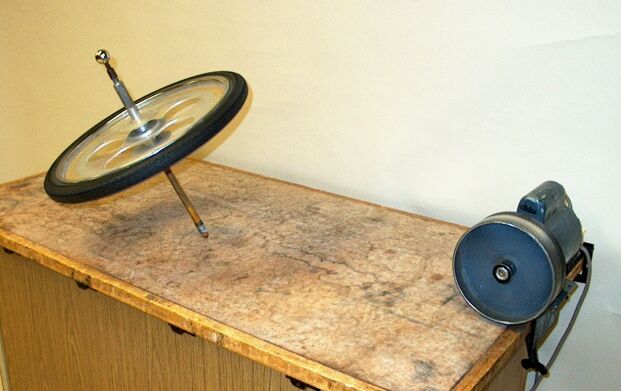
Switch on the motor and, holding the axle horizontal in front of you, set the wheel spinning by pressing the tire against the large pulley on the motor. Now set the spinning wheel on the table, on the pointed end of its axle. Instead of falling, the wheel precesses as would a spinning top. You can set the wheel spinning in the opposite direction and again set it on the table, to show that it now precesses in the opposite direction.
The physics illustrated in this demonstration is similar or identical to that in demonstrations 28.57 -- Bicycle wheel precession, 28.60 -- Maxwell’s top, and 28.63 -- Rotating wheel in suitcase.
Just as an object moving in a straight line has linear momentum, a rotating object has angular momentum. This angular momentum is L = Iω, where I is the moment of inertia of the object, and ω is the angular velocity with which you have set it spinning. L points along the central axis of the object, and its sense is given by the right-hand rule. If you curl the fingers of your right hand in the direction in which the object is spinning, your extended thumb points in the direction of L. Thus, a spinning top has angular momentum, which points downward if the top is spinning clockwise as viewed from above, and upward if the top is spinning counterclockwise as viewed from above.
Unless the center of mass of the top is exactly above the pivot point, gravity exerts a torque on the top at the center of mass, about the pivot point. If the top is not spinning, it merely falls. When the top is spinning, however, it has angular momentum, so it cannot fall, but must move in the direction dictated by the change in angular momentum introduced by the torque exerted by gravity; it precesses. The bicycle wheel used in this demonstration has a point at one end of its axle, so that you can set it spinning and then set it on the table on its point as you would a spinning top, and watch it precess.
For a top, if r is the position of the center of mass relative to the pivot point, the torque from gravity is τ = r × mg, where m is the mass of the top and g is the acceleration due to gravity. It points outward from the pivot point, along the plane on which the top sits, perpendular to r and mg, and rotates about the pivot point as the top precesses. The change in angular momentum equals this torque, or τ = dL/dt. Thus, the change in angular momentum – the precession – is in the direction of the torque exerted by gravity, and for a small time interval, ΔL = τΔt. L + ΔL has the same magnitude as L, but its head is displaced with respect to that of L by an angle φ, the angle made by the (horizontal) radii from L and L + ΔL to the vertical line above the pivot point. (If we place the pivot point at the origin of a set of coordinate axes, this is the z-axis.) The rate at which L precesses, then, is ωp = Δφ/Δt. If we call the angle that L makes with the z-axis, θ, then the (horizontal) radius from the tip of L to the z-axis is L sin θ. (θ is also the angle that mg makes with r.) Since ΔL is very small compared to L (and to L sin θ), for an incremental change in φ, Δφ ≅ ΔL/(L sin θ), and Δφ = τ Δt/(L sin θ), so ωp = τ/(L sin θ). τ = rmg sin θ, so ωp = rmg/L, or ωp = rmg/Iω. (If we rewrite ωp = τ/(L sin θ) as τ = ωp L sin θ, we see that this torque is also the cross product of the precession velocity and the angular momentum: τ = ωp × L.) We see that the faster the bicycle wheel spins, the more slowly it precesses, and vice versa, and when you perform the demonstration, as the wheel slows down, its rate of precession increases.
The motor pulley as it is shown in the photograph above rotates in the clockwise direction. So when you hold the bicycle wheel against it, it spins the bicycle wheel counterclockwise. Its angular momentum vector L, then, points toward the front of the table, or to your left. If the pointed end of the axle is on the left, then when you set the wheel on the table, it spins clockwise as viewed from above, and L points downward. Since the change in angular momentum produced by the torque exerted by gravity is in the same direction as this torque, if the wheel rotates in the clockwise direction, it precesses in the clockwise direction. (Imagine moving the tip of L in the direction of τ.) If the pointed end of the axle is on the right when you set the wheel spinning, then when you set the wheel on the table, it spins counterclockwise as viewed from above, and L points upward. Again, because the direction of the precession is the same as that of the torque due to gravity, the wheel precesses in the counterclockwise direction.
References:
1) Resnick, Robert and Halliday, David. Physics, Part One, Third Edition (New York: John Wiley and Sons, 1977), pp. 260-262.
2) http://hyperphysics.phy-astr.gsu.edu entry on precession of a spinning top.
3) http://hyperphysics.phy-astr.gsu.edu/hbase/rotv2.html#rvec4 entry on precession torque.